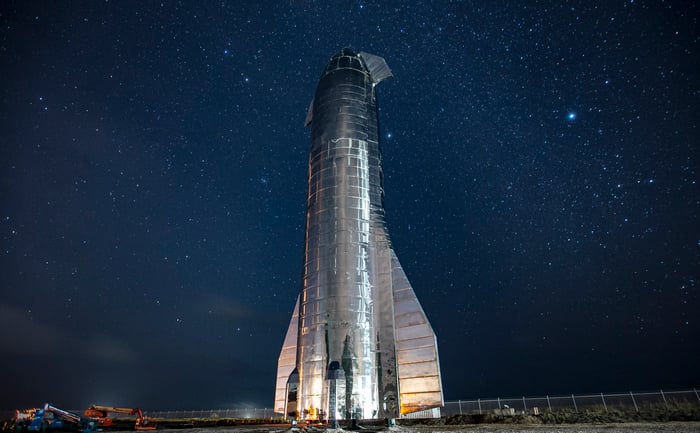Elon Musk wants to revolutionize spaceflight -- and lower the cost of a space launch by nearly 99%.
In 2010, SpaceX's founder and CEO took a first step toward this goal with the launch of a Falcon 9 rocket. Priced at $61 million, Falcon 9 cost just 15% the price charged for the Delta IV Heavy rockets ($400 million) it competed with. And in 2018, ahead of the first launch of an improved "Block 5" Falcon 9, Musk promised to lower the cost to less than $5 million.
Abracadabra, at $4 million and change, SpaceX would reduce the cost of space launch by 99%.
Or so we thought. In 2022, SpaceX didn't lower, but raised its price to $67 million. How then does Musk plan to get prices shrinking again and complete his march toward a 99% reduction in cost?
With Starship.

Image source: SpaceX.
What is Starship?
First envisioned as a "Big [Freakin'] Rocket" to carry colonists to Mars, SpaceX's Starship -- at 121 meters tall when mounted atop a SpaceX Super Heavy first-stage booster -- has become the largest rocket ever built, boasting a payload 5 to 10 times what Falcon 9 can carry.
Of course, the question is: If Starship is so big and so powerful, how can it be 100 times cheaper than the rockets it aims to replace?
How much does Starship cost?
This is not the easiest question to answer. But in a recent 36-page report, Payload Research took a stab at it, breaking down Starship's costs piece by piece and explaining not only how much Starship costs to build, but also how much SpaceX might charge for it -- hinting at the profit SpaceX might earn from it.
For example, to be a viable launch vehicle, Starship needs a launch pad. So the first thing SpaceX needed to do was build a "Starbase" and all the infrastructure needed to support it, including the gigantic "Mechazilla" launch and landing tower that stacks Starship on Super Heavy for launch, then catches each segment of the space vehicle at landing. Just building Starbase cost SpaceX $3 billion.
Next, there's Starship itself (and its Super Heavy booster rocket). SpaceX has spent $5 billion on Starship research and development to date, and testing is ongoing. When all's said and done, Starship's R&D total costs could approach $10 billion, not counting the cost to build each individual Starship after commercial operations commence.
Amortizing these costs across the first few units could yield a price tag of "hundreds of millions of dollars ... for early Starship prototypes," says Payload. Assuming each Starship flies up to 100 times, though, the cost of each flight should decline steadily as SpaceX gets more use out of the ship.
What's more, once R&D costs have been fully amortized (so that they no longer need to be attributed to the cost of each new spaceship built), Payload estimates Starship's cost will look something like this:
- Structure, plumbing, tiles, parts: $13 million
- Avionics: $3 million
- 39 Raptor engines: $39 million
- Labor: $35 million
That adds up to a total input cost of $90 million.
Payload further breaks down the costs to attribute 70% ($63 million) to the cost of building a Super Heavy booster and 30% ($27 million) to Starship proper. This is important because Super Heavy's primary role will be launching multiple Starships to orbit, where they can operate without boosters. Once things are up and running, SpaceX might build as few as one Super Heavy booster per every 10 Starships.
How much will Starship cost in the future?
Early-version Raptor engines cost approximately $2 million each, and Payload estimates SpaceX has already cut that figure in half. SpaceX intends to keep shaving costs until it can build Raptors for as little as $250,000 -- a reduction that cut another $30 million off the total cost, resulting in a $60 million price tag.
SpaceX further intends to build a Starfactory to build Starships and Super Heavy boosters assembly-line style, adding efficiency and reducing the labor costs. Payload estimates that if SpaceX can move from building "roughly three fully stacked Starships per year" to assembling "multiple Starships per week," the efficiency gains could save another $25 million per Starship.
Subtract another $25 million. Now Starship will cost just $35 million!
Now, Musk has stated that Starship will eventually cost it only $10 million per flight. Payload's calculations -- including projected cost cuts that won't materialize for years -- fails to work the price all the way down to that point. However, if Payload is correct about it costing $35 million to build a single Starship, this would mean that even with fuel expenses of $1 million per launch, each Starship should only need to fly about four times to get the average cost to SpaceX per flight down to $10 million.
And if a single Starship can fly five or more flights before SpaceX needs to retire it? "The marginal cost to launch Starship could drop well below $10M in the long-run," opines Payload (emphasis added).
The upshot for space investors
The math here isn't hard. Assuming Payload Research's numbers are even in the ballpark (and they look pretty close to me), a SpaceX that builds Starships for $10 million (per flight) should be able to underprice every other rocket company on Earth (most charge $100 million and up) by charging any price SpaceX wants to -- from, say, $20 million all the way up to $100 million.
The gross profit margins will still be enormous, and SpaceX will dominate space launch for years to come.




